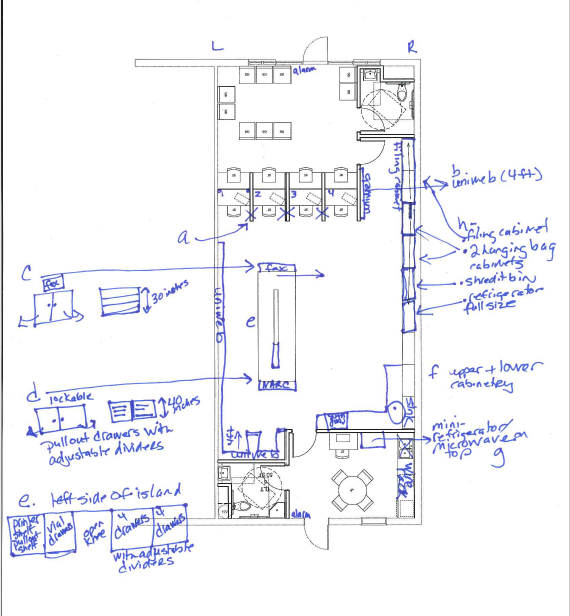Tip: Be creative when you think of space. Charitable pharmacies are located in churches and thrift shops as well as departments of health and clinics. Where do the people you plan to serve go?
Facility needs include any components needed to run and operate a pharmacy. Follow any state board of pharmacy requirements for specifics in terms of space, water supply, security systems, and others.
The location of the pharmacy needs to be easily accessible and as close to the population you are trying to serve as possible. Are there other pharmacies or even charitable pharmacies already in the area? Was the location picked because of the absence of a charitable pharmacy presence or is there a certain patient-specific population that is being underserved? Are there enough patients in need of your services in the area? See Local Factors for Community Charitable Pharmacy Implementation. Location is pivotal and must be chosen wisely. Only decide on a location when there is enough data to support that the new facility will be able to operate successfully.
Patient transportation to your facility is key to accessibility. Factors to consider include:
- Convenience and accessibility
- Proximity to local clinics or other healthcare services
- Near local bus or public transportation stop
- Adequate parking
Include public transportation information (bus route, subway stop, etc.) on maps and marketing materials.
The new facility must be able to meet the needs of a specific population and area, thereby creating the charitable pharmacy’s own unique market. Anticipate growth. Once clinics, hospitals, and patients discover the value of a charitable pharmacy, numbers of new patients and prescriptions will accelerate rapidly. If possible, build this growth into your budget (for staffing as well as purchasing) and space.
Dedicate space for:
Pharmacy
- Inventory: segregated medication from various suppliers (if required)
- Records: prescription files, patient files, pharmacy records
- Bulk supplies: vials, labels, office supplies
- Med destruction
- Patient Education materials
Enrollment area: enrollment may take 30-60 minutes for a new patient, 10-15 minutes for re-enrollmentInventory: segregated medication from various suppliers (if required)
Records: prescription files, patient files, pharmacy records
Bulk supplies: vials, labels, office supplies
Med destruction
Patient Education materials
Dispensing and counseling area: cash register, will-call space, etc.
Extended services: MTM, multi-language counselling, device use, immunizations, etc.
- Space to allow privacy and meet HIPAA regulations
- Area for students and/or volunteers
- Office
Staff eating and break area separate from the medication storage area
For mail-order, shipping area: both for arrival of donations and for outgoing prescriptions
Waiting area large enough to accommodate population:
- Stand-alone pharmacy – sitting and roaming aisles
- Shared space if in a clinic, hospital or other shared location
A suggested starting size is 1,000 square feet, designing up or down depending on final size of facility. Here are some examples of the square feet needed compared to the number of prescriptions filled used by St. Thomas Health in Tennessee:
- Busy hospital outpatient pharmacy that provides employee prescriptions, retail and discharge prescriptions, and Dispensary of Hope medications. Metrics: 1,507 square feet to fill 6,786 prescriptions during Sept 2017
- Hospital outpatient pharmacy that solely provides prescriptions for indigent patients. Metrics: 808 square feet to fill 3,368 prescriptions during Sept 2017
- Pharmacy within a clinic that provides employee prescriptions for the hospital nearby, retail prescriptions for the clinic, and Dispensary of Hope prescriptions. Metrics: 1,200 square feet to fill 3,643 prescriptions during Sept 2017
- Pharmacy within a rural clinic that provides prescriptions for the hospital nearby, retail prescriptions for the behavioral health clinic, and Dispensary of Hope prescriptions. 559 square feet to fill 115 prescriptions during Sept 2017 (opened August 2017)
TIP: Think where you hope to be in 5 or 10 years. Plan for additional inventory, staff, volunteers, and services. WMDP started with 1,000 square feet for their mail-order charitable pharmacy. Ten years later, in 2018, they moved to a 4,000 square-foot facility to relieve a very cramped space. What do you plan to add in the future? Who will be helping you?
Startup hours of operation factor in funding, services offered, and size of the population to be served. Many stand-alone or community collaborative charitable pharmacies begin with three days per week (21 to 24 hours/week). If the charitable pharmacy is to be affiliated with a clinic or hospital with an established population, five days a week may be feasible.
Limited hours of operation provide time for marketing to community and health care referral sources, funders, and patients. Even with community support, presentations to clinics (social workers as well as providers), and health fairs, church groups, libraries, etc. are needed to introduce your pharmacy and its services to the community and establish your reputation (See: Where to start).
Hours of operation may need to be adjusted to better meet the community need. Examples: Open early or close later one day a week to accommodate patients who are working; closed on Wednesday as clinics do not have specialties open on Wednesdays; open on Friday afternoon to accommodate discharge patients. Check with local health care facilities to determine when their disease state clinics are run to best offer your services to their patients.
Follow any state board of pharmacy guidelines for specifics on required equipment.
Office |
Pharmacy
|
Fixtures/
|
|---|---|---|
|
|
|
Listed below are the categories to consider when making decisions regarding types of technology required. Technology matches the unique services offered by the pharmacy to allow smooth and efficient operations. See Pharmacy Management Systems for pharmacy operating systems.
General |
Optional |
Pharmacy specific |
Billing |
|---|---|---|---|
|
|
|
|
For Start-Up Costs see Start-Up Costs.
Get access to the full playbook
Get instant access to the full playbook, with more than 150 pages of valuable guidance, case studies and resources to help you develop your charitable pharmacy.


